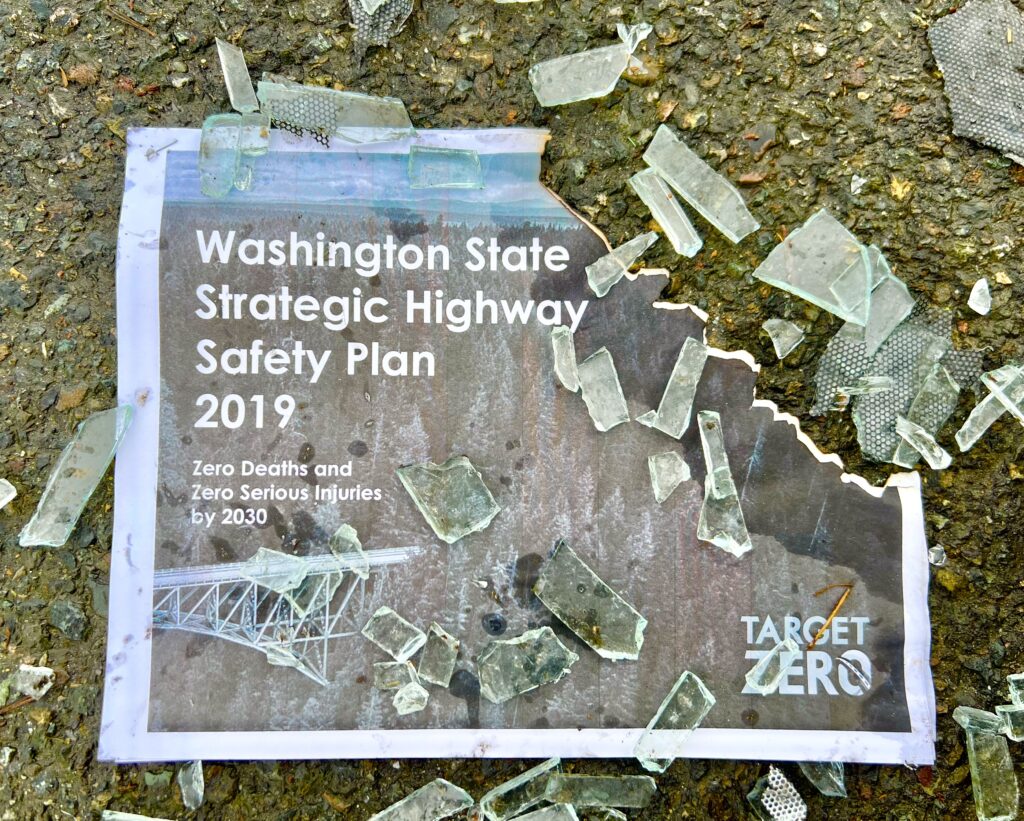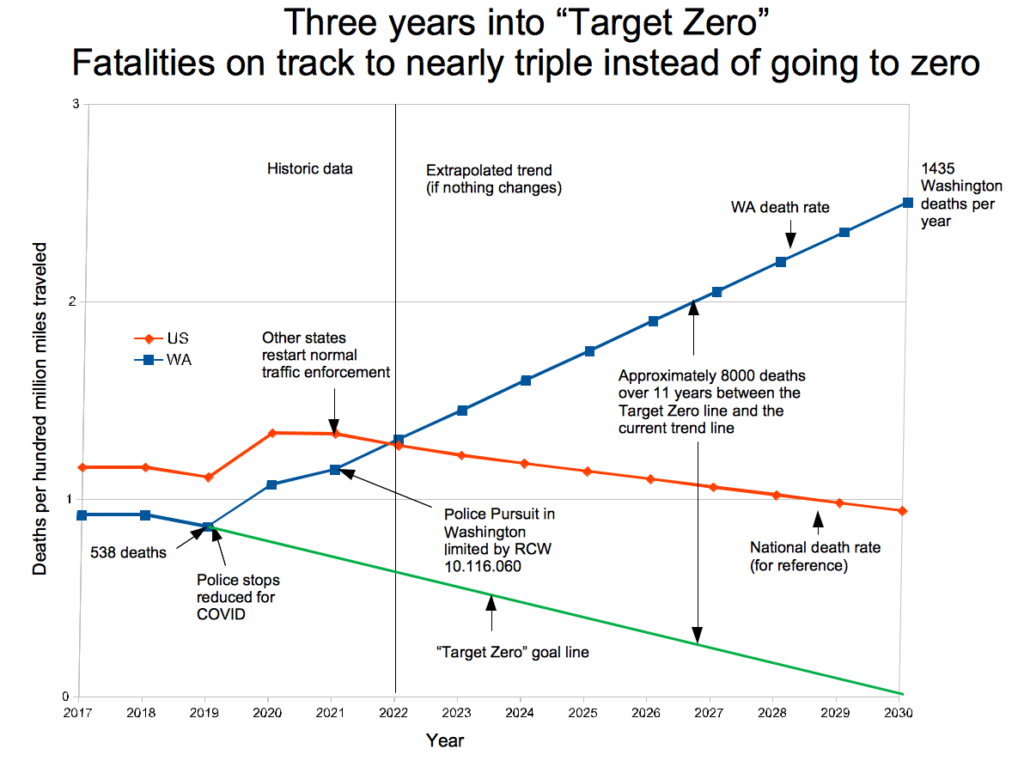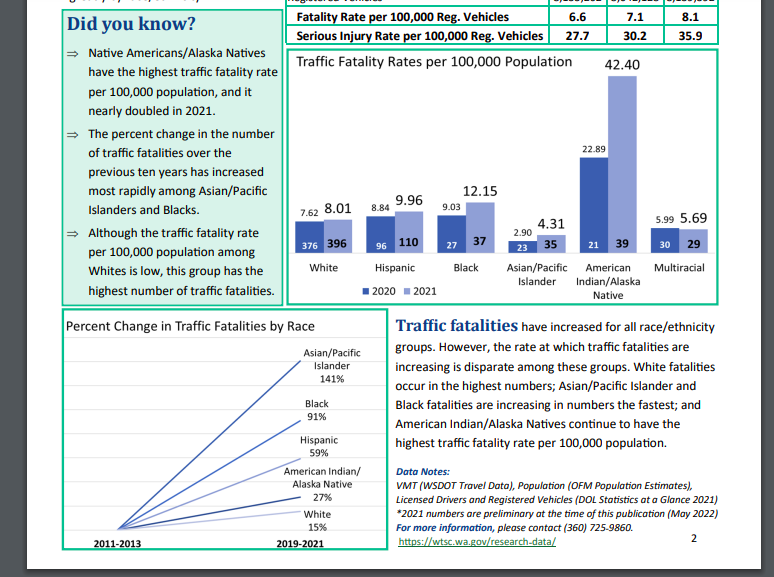
The plan was to reduce highway deaths to zero by 2030. Instead, we’re on path to triple the number of fatalities, producing EIGHT THOUSAND avoidable deaths of Washingtonians by 2030. BIPOC residents will be hit the hardest.
In 2018 our state lawmakers asked our Washington Transportation Highway Commission to create an ambitious plan to further improve road and highway safety. The Commission’s resulting comprehensive 296-page plan boldly set a stretch goal of eliminating ALL fatalities by 2030. They made progress at first. But then the legislature passed the non-pursuit law, RCW 10.116.060, that put us on path to instead nearly TRIPLE fatalities by 2030. If nothing changes, eight thousand Washingtonians are projected to be killed in car crashes by this ill-conceived law by the year 2030. Tens of thousands more will needlessly suffer head injuries, lose limbs, or sustain other life-altering maimings.
The Transportation Commission’s admirable “Target Zero” plan includes detailed steps to eliminate accident sources from DUIs, distracted drivers, unlicensed drivers, and all other root causes for accidents. Most of the remedies are new laws and enforcement, like lower allowed blood alcohol levels, police emphasis patrols, automated ticketing, and DUI checkpoints.
Within months of adoption of the report, COVID-19 hit Washington state, and traffic stops were greatly reduced while courts were closed. Police agencies nationwide began prioritizing only the most dangerous traffic violators. As a result, crash fatality rates shot up even though roads were less crowded, as some drivers learned they could speed, run stop signs, and commit other mayhem, with little risk of a ticket.
As the rest of the nation began enforcing all laws again in 2021, Washington State went the opposite direction, choosing to limit police pursuit of non-violent offenders, giving effectively a free-pass to the worst drivers. Even drunk drivers have a new way out.
(Above chart prepared from state and federal official data sources given here.)
This is far from theoretical. Some residents, like a grieving woman who contacted me online, have recently buried family members killed by reckless drivers, or they have sustained injuries themselves. And most drivers in our community have harrowing stories about near-misses or fender-benders, often with cars lacking license plates or having a tell-tale broken window that reveals it is stolen. These reckless, uncaring drivers zip past police with impunity, because they can’t be pursued by state law, and there’s no way to know who is driving.
The legislature is currently considering rolling back the non-pursuit law, and I urge you to contact them and give them your encouragement. Restoring police traffic enforcement authority would be a critical first step in making “Target Zero” a viable plan again as opposed to just more road litter.




What’s the data for total number of police stops by year? Does this correlate with the number of fatalities?
Excellent question, thanks. I’ve been looking for this type of data, but it’s really hard to find. There have been contradictory studies over the years about whether more frequent stops help or hurt public safety. My hypothesis at this time is that the police need to have the authority to get the most reckless drivers and stolen cars off the road, but that doesn’t mean more stops are necessary. It just means that when they decide to stop someone, it should not be voluntary. Usually someone who flees a stop will have a reason like a suspended license, stolen car, be a fugitive, be transporting drugs for sale, or be under the influence. All valid reasons to get them off the road. I never liked police quotas, where officers needed to write a certain number of tickets, and to my knowledge our department generally stayed away from them (there may have been an exception in emphasis patrols).
The reason I wrote yesterday’s blog post about how 85 percent of the drivers set the speed limit was to get at this question. I think there is very little value in police pulling over any of the 85 percent that normally drive below the limit. Even if one of them goes over the limit briefly (say on a downgrade), if they’re the type that typically drive below or at the limit, and they are licensed, their cars registered, and they are insured, the stop will probably not do much for safety. You could double or triple the number of stops on this group of people, and it won’t impact safety. But if you stop enforcing the law on the worst of the reckless or malicious drivers, that will impact safety. Here’s a link to yesterday’s blog entry to see what I mean. Thanks for the question. https://www.randycorman.com/?p=10980
Thanks for the thoughtful response Randy!